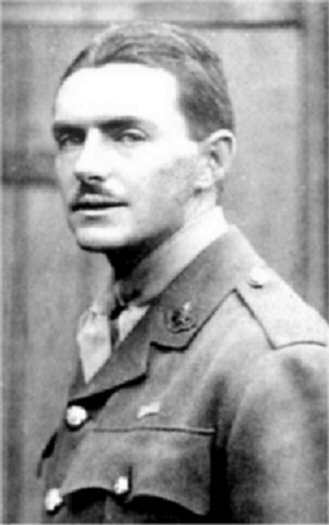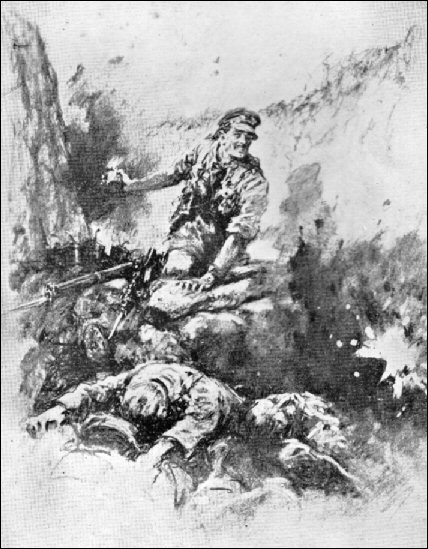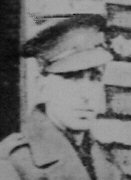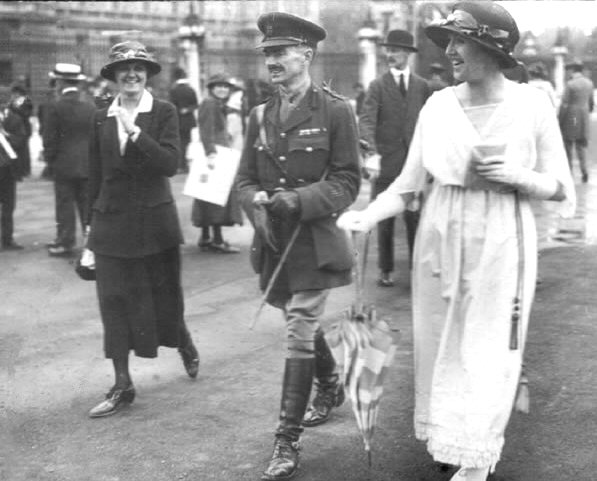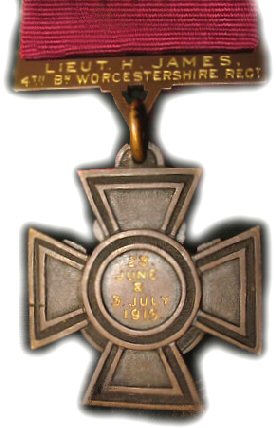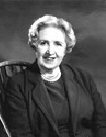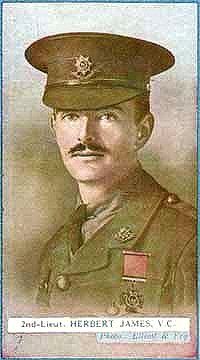Lieutenant Herbert JAMES V.C., M.C.
Herbert James was born in Ladywood, Birmingham on the 13th November 1888, son of Walter James (engraver and gold jeweller) and Emily James. He was educated at Smethwick Central School. He later became a teacher at Bearwood Road School and Brasshouse Lane School, both in Smethwick. He joined the army in 1909 with the 21st Lancers and served with them as a Private soldier in Egypt. At the outbreak of World War One, he was promoted and commissioned into the 4th Battalion the Worcestershire Regiment. On the 22nd March 1915 the 4th Battalion reassembled at Avonmouth and embarked. On the 27th March the convoy steamed straight through the Straits of Gibraltar and on without a check into the Mediterranean. Malta was reached on the 31st March and then sailed on to Alexandria the next day, arriving on Easter Sunday, 4th April. On the 11th April the battalion sailed form Alexandria and, after passing safely through the Aegean Islands, reached the rendezvous at Lemno on April 13th. There was found a great concourseof warships and transports, and there was much of interest to divert the attention of the troops during the ensuing week. His citation reads: "For most conspicuous bravery during the operations in the Southern Zone of the Gallipoli Peninsula. On 28th June 1915, when a portion of the regiment had been checked, owing to all the officers being put out of action, Second-Lieutenant James, who belonged to a neighbouring Unit, entirely on his own initiative, gathered together a body of men and led them forward under heavy shell and rifle fire. He then returned, organised a second party and again advanced. His gallant example put fresh life into the attack. On 3rd July, in the same locality, Second-Lieutenant James headed a party of bomb throwers up a Turkish communication trench and after nearly all his bomb throwers had been killed or wounded, he remained alone at the head of the trench and kept back the enemy single-handed until a barrier had been built behind him and the trench secured. He was throughout exposed to murderous fire." (London Gazette 1st September 1915) |
Lieutenant Herbert James V.C. |
Below is an account of the 4th Battalions action at Gully Ravine, Gallipoli, and how Lieut. James won his Victoria Cross.
ACTION OF GULLY RAVINE (28th June to 3rd July 1915)
A new attack had now been planned. Immediately in front of the 88th Brigade the Turkish defences were formidable, but there seemed reason to hope that an advance up Gully Ravine might prove more successful. Careful preparations were made for the attack. By June 28th all was ready and at 9.0 a.m. that morning the British guns opened fire. At 10.0 a.m. the attacking troops advanced. The Worcestershire were not actually involved in that attack, their role being confined to holding the Brigade line further to the right, but the Battalion came in for heavy gun fire while the struggle on their left swayed to and fro. On the left flank the Turkish defences along the sea cliffs were taken with comparative ease; but in the Gully Ravine itself the fire of two strong redoubts held up the attack and drove the attacking Lowland Battalions back into our lines.
That evening the Essex and 5th Royal Scots renewed the attack on those two redoubts, only to fail in their turn.
The 5th Royal Scots in particular were heavily punished, and most of their company officers were killed or wounded. Orders had been given that the 4th Worcestershire further to the right were to keep touch with the Scotsmen and to be ready to exploit any success. For that purpose Lieut. H. James of the Worcestershire had been sent into the trenches of the Royal Scots to act as liaison officer. When affairs became critical Lieut. James went up to the front line, at the request of the Royal Scots' commanding officer, to assist the attack. All the Scots officers in his vicinity had fallen, so Lieut. James took command of the disorganised troops around him, restored order and established a satisfactory position. Then he went back and brought up reinforcements, only to find on his return that a renewed counter-attack by the enemy had shattered the defence. Once again Lieut. James re-established the line and maintained the defence until darkness fell.
During the next three days fighting surged forwards and backwards along the trenches in the Gully Ravine. Gradually the enemy were driven from their advanced lines, and by nightfall of July 1st the line on each side of the Ravine had been materially advanced; but in front of the 88th Brigade the enemy's trenches were unchanged, and formed a salient which invited attack.
Attack on that salient was organised; an attack to be made by the Worcestershire and Hampshire. After due consideration it was decided that, in view of the increasing shortage of gun ammunition, a bombing attack up the existing saps would be preferable to a big attack over the open. Two saps in the centre of the hostile line were assigned to the Worcestershire ; other saps further to the left were allotted to the Hampshire. The Essex and Royal Scots held the British front line in support of the attacking parties.
At 9.0 a.m. on July 2nd the attack began. The attacking parties climbed out of our own sapheads, dashed across the open, rushed the sapheads of the enemy and made their way forward up the trenches. The two Turkish sapheads assigned to the 4th Worcestershire were each attacked by a party of about 30 men, those on the right being led by Lieut. Mould and those on the left by Lieut. James.
At first all went well. The enemy, surprised by the unusual hour of attack, fell back along the trench and Lieut. James' party were able to make their way up the saphead. Their advance was difficult, for the winding trench was full of dead bodies. Since June 4th fight after fight had raged along it and soldiers of all ranks (including even a dead General; a Brigadier of the Lowland Division) were now heaped in the trench, some half buried by fallen sand, others but newly killed.
Lieutenant Herbert James defending the sap in Gully Ravine (Drawing by Gilbert Holiday) |
The bombers advanced up the saphead to the trench junction at its further end. There the enemy were in waiting, and a furious bombing fight ensued. The enemy were well provided with bombs (In Gallipoli the British forces had at that date only " jam-tin " bombs. The Turks were supplied with spherical Lieut. James sent the corporal (Lance-Corporal R. Reece) back to bring help and faced the enemy alone. The Turks were organizing a counter-attack. A cluster of bayonets could be seen over the top of the trench. Presently came a shower of bornbs and the bayonets moved forward. Before that attack the subaltern fell back along the winding trench, holding back the pursuit by bombing from each successive bend. The enemy followed. Halfway back along the saphead Lieut. James came to a point where a heap of dead bodies blocked the trench. There he found one of his bombers, Private Parry, lying wounded. To protect him Lieut. James turned to bay. Hastily forming a low barricade of sand bags (At that point was a small 'dump' of bombs and sand bags) on top of dead bodies, the subaltern organised a temporary defence. With two rifles and a sack of bombs, Lieut. James held the trench single handed, alternately lying behind his barricade to fire and then rising to bomb the Turks after his rifle fire had driven them back behind cover. Amid a shower of bombs he held his ground until the arrival of reinforcements headed by Sergt.-Major Felix. A barricade was built further down the trench, and the wounded Private Parry was got back to safety. The reinforcements had been fetched by Corporal R. Reece. While the barricade behind was being built Corporal Reece joined Lieut. James and assisted in his defence. He was awarded the D.C.M. for his gallant work. The exact length of time during which Lieut. James held his barricade can never be known, but during that time he expended nearly the whole of his sack of bombs. Then at last Lieut. James fell back behind the new barricade. The Turkish attack was stopped and the fight died down. |
For his gallantry in that fight and in the preceding action Lieut. James was awarded the Victoria Cross; being the first of the Regiment to gain that highest reward of valour. While Lieut. James had been battling in the left hand sap, the other bombing party under Lieut. Mould in the right hand sap had been waging a similar fight, equally gallant but equally unsuccessful (Lieut. Mould subsequently received the M.C.). Nor had the Hampshire bombers further along the line made any greater impression. By midday it was realised that the attack was futile, and gradually the fighting came to an end. With the action of Gully Ravine the first phase of the operations on the Gallipoli Peninsula may be said to have come to an end. In nine weeks of continuous fighting the 29th Division and the other troops at Helles had fought their way forward to the outskirts of Krithia, in the face of an enemy at least equal in numbers, amply supported by artillery and strongly entrenched. The British battalions had made attack after attack,each time with heavy loss and each time,unfortunately, with incomplete success. But the keen Regimental spirit of officers and men had spurred them on and had held them to their task. |
Lieut. James Mould |
That Regimental spirit had been fostered in time of peace, almost insensibly, by endless competition against other regiments in games and sport as well as in military training. Now the labour of years bore fruit in a pride which developed, as time went on, into a firm belief of an efficiency superior in every way to that of other units. In the very sentences with which the diarist of the 4th Worcestershire recorded the shortcomings of other regiments in such details as the construction and maintenance of trenches, he recorded also, as a matier of course, the steps immediately taken by the Battalion to put things right. Nor was that assumption of superiority altogether unwarranted. From the Landing onwards the 4th Worcestershire established a reputation second to none in the Division. The character of the Battalion was quickly realised, and within the first week of the campaign a special Brigade Order (issued on May 1st) bore witness.
"The Brigade Commander," the order ran, "wishes to place on record the great gallantry and devotion to duty displayed by Lieut. Colonel D. E. Cayley and the officers and men of the 4th Battalion Worcestershire Regiment during the operations since landing was effected on the Gallipoli Peninsula. The Battalion has always been well in hand and not a single straggler has been reported. They are a splendid example to the Brigade."
From that time onwards the 4th Worcestershire maintained the same spirit, and it was that spirit which kept them in fighting trim despite the incessant losses, the no less incessant labour, the ever increasing heat and the manifold discomforts of the campaign.
Constantly they were on trial, and on trial before the sternest of critics, the other proud battalions which built up the Division; and from trials passed in Common and from victories dearly bought there arose gradually a mutual pride in their association which gave the 29th Division, perhaps beyond any other Division in the Army at that time, an individuality and a soul. A confidence was born that the Division could not be defeated; and that confidence kept all keyed to the utmost effort, despite the apparent hopelessness of their task.
That task had indeed been recognised by that time to be so formidable that new means being sought to accomplish it, and a new venture had been planned.
Lieutenant Herbert James appointed Adjutant of the Battalion
By August 1915 Lieut. James was serving as Adjutant, in which capacity he made regular habit of going out in search of wounded in No Man’s Land during the night, on one occasion dragging back two men single-handed. As with his earlier V.C. exploits, most were amazed that he emerged unscathed from such gallant forays, but on the night of 27/28 September 1915, while visiting one of his battalion’s advanced saps, his luck ran out and he received a serious foot wound. He was evacuated to hospital at Cairo.
After treatment he was then sent home in mid-November on a month’s sick leave, arriving at Southampton. This remarkably quiet and modest man deliberately took an earlier train home to Birmingham than expected, thereby avoiding the large reception afforded fellow V.C., Lance-Corporal Arthur Vickers of the Warwickshires, who was travelling on the same train - James quietly left the station by taxi. Inevitably, however, it was impossible to avoid the growing clamour for his attendance at assorted civic receptions, among them a special ceremony in Victoria Square, hosted by the city’s Lord Mayor, Neville Chamberlain, the future Prime Minister, and a trip to his old school to be presented with a splendid “Sword of Honour” - but on all such occasions James spoke but briefly.
Lieutenant Herbert James V.C. with his wife Gladys arriving at Buckingham Palace |
Herbert James was invested with his Victoria Cross by H.M. King George V at Buckingham Palace on the 15th January 1916. |
Victoria Cross engraved on back |
Returning to active service in March 1916 joining the 1st Battalion Worcestershire Regiment at the Somme, and commaded 'B' Company. On the 7th July 1916, during the attack on the village of Contalmaison he was wounded in a fierce hand-to-hand encounter in the ruins of the village of Contalmaison on, and was evacuated to a hospital on the Isle of Wight and thence to the mainland - it was on this occasion that his wounds necessitated him having a silver plate inserted in his head.
Glady B. Lillicrap |
While still recuperating from his wounds he found time to marry Gladys Beatrice Lillicrap at Stoke Darverel Parish Church in Devonport in later part of 1916. A year later they had a son Anthony Howard James, who would in later life also become a serving officer with the 1st Battalion Worcestershire Regiment in the Second World War. James returned again to the army; on 1st May 1917 he was awarded the French Croix De Guerre. Then later on 18th August 1917 he was promoted to General Staff Officer (grade 3) with the rank of Temporary Captain. On the 1st April 1918 he was promoted to Brigade Major. In what was to be an eventful year for James he was further awarded a Mention-in-Despatches on 20th May, then a Military Cross for his deeds near Amiens (London Gazette 16th October 1918) and finally another Mention-in-Despatches on 20th December! James stayed on in the army following the Armistice. On 17th February 1920 he received yet another award when he received the Bronze Medal (3rd class) of La Solidaridad of Panama (London Gazette 17 February 1920 refers), Panama having declared war on Austria in December 1917. |
Military Cross citation reads:
"During an attack, he rode forward when the situation was obscure under heavy fire, and brought back most valuable information. He then reorganised and led forward parties of men from other units and skilfully formed a defensive flank where a gap had occurred, exposing himself for many hours to a very heavy fire. By his gallantry, coolness, and utter disregard of personal safety, he set a splendid example to all ranks." (London Gazette 16th October 1918)
On the 26th June 1920, James attended the Afternoon Party gathering at Buckingham Palace for recipients of the Victoria Cross. The men were inspected by H.M. George V and Queen Mary. Later the same year on the 11th November he was chosen for the Honour Guard at the ceremony marking the burial of the Unknown Warrior at Westminster Abbey.
On the 21st December 1920 he transferred to the East Lancashire Regiment as Captain and Brevet Major. He served with them in the West Indies for a time before entering Staff College and then taking up a post as Staff Captain at the War Office.
His next move was to be a Brigade Major at the Aldershot Command in October 1927 where he stayed there untill November 1928. At the end of that spell he transferred to his final command, which was as a Major with the Yorkshire and Lancashire Regiment. At some point during this period he separated from, and divorced, his wife Gladys. On 26th November 1929 he married for the second time, to Jessie Amy England in London . His health by now was probably already bad and he finally retired from the army in March 1930 through ill health.
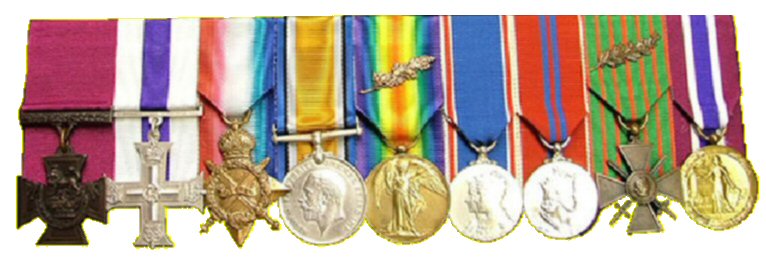
Herbert James, V.C., M.C. medal group
(Medals: Victoria Cross; Military Cross; 1914/15 Star; British War Medal; Victory Medal with Mentioned in Dispatches emblem;
Coronation Medal GVI - 1937; Coronation Medal EIIR - 1953; French Croix de Guerre with palm; Panama Medal De La Solidaridad 1917)
Shortly after, James’s second marriage appears to have broken down around this time. In 1957 he was living alone in a first floor back room flat at Brunswick Gardens in Kensington, London. Here he apparently pursued an interest in trading oil paintings and lived as something of a recluse. In August 1958 he was taken ill but it took a while for anyone to notice anything out of the ordinary as his landlord George Purvis explained:
“Sometimes at night he shouted in his sleep, and made moaning noises which lasted for about five minutes and occurred about every hour. We took it that he was a troubled sleeper”. “But last night the nature of the moaning changed and it alarmed my sister Veronica who told me of her fears when I returned about 11pm. After we had unsuccessfully tried to open the door of his room I dialled 999 for an ambulance”.
The ambulance crew arrived and entered the room by forcing open the window, which overlooked the rear garden. They found him lying in the hearth clad in pyjamas and dressing gown. Their immediate prognosis was that he had had a seizure. It was further reckoned he had lain ill and starving for about six days. He was taken to a London Hospital but died there on the 15th August 1958 . It was stated that the cause of death was uraemia and a heart attack. The following day George Purvis, the landlord, checked the room over, he picked up a book from the floor of a complete list of VC recipients open to the page against Major James' name, under which was a pencil line. That was the first he new that Herbert James was the holder of the Victoria Cross. There were also 23 oil paintings on the walls and one or two notes concerning sales at Sothebys, but no sign of the Victoria Cross, or indeed any medals. The funeral was held at St Mary Abbot’s Church, Kensington on the 20th August 1958. Following the service his body was taken to the West London Crematorium, Kensal Green. The funeral was attended by the Deputy Supreme Allied Commander in Europe, General Sir Richard Gale, the Colonel of the Worcestershires and other comrades from the regiment including; Brigadier H. U. Richards, Lieut.-Colonel P. W. Hargreaves (representing the London and Home Counties branch of the W.R.A.), Capt. A. Bradish (representing the W.R.A.), Major J. D. Reynolds, and R.S.M. T. Hands (representing the Depot), also Serjeant Spelman and Privates Cook, Smith, Roberts, Winkett, Hopkins, Sweet and Orme from the Depot, who acted as bearers. His son, Major A. H. James, serving with the 1st Battalion Worcestershire Regiment, was unable to attend. Major James has no known memorials but a dramatic drawing of him defending the sap in Gully Ravine, by Gilbert Holliday, is owned by the Worcestershire Regiment Museum - it was presented to the museum by Lieutenant J. M. P. Baird, one of James’ Gallipoli contemporaries and was exhibited at Marlborough House at the time of the V.C. centenary celebrations in 1956. |
Gallahers cigarette card |
Major James' ashes were scattered in the Crematorium gardens. No memorial to James was erected anywhere.
On the 25th June 2008 Major Herbert James' medals were sold at auction by order of the family, by Dix Noonan Webb at the Washington Mayfair Hotel, in Curzon Street, London. The hammer price was £180,000. The purchaser of the group was John Meyers who is well known in Australia as a Victoria Cross collector and who runs his own military museum in Maryborough, Queensland, Australia. The Victoria Cross medal group is now on display in the museum.

